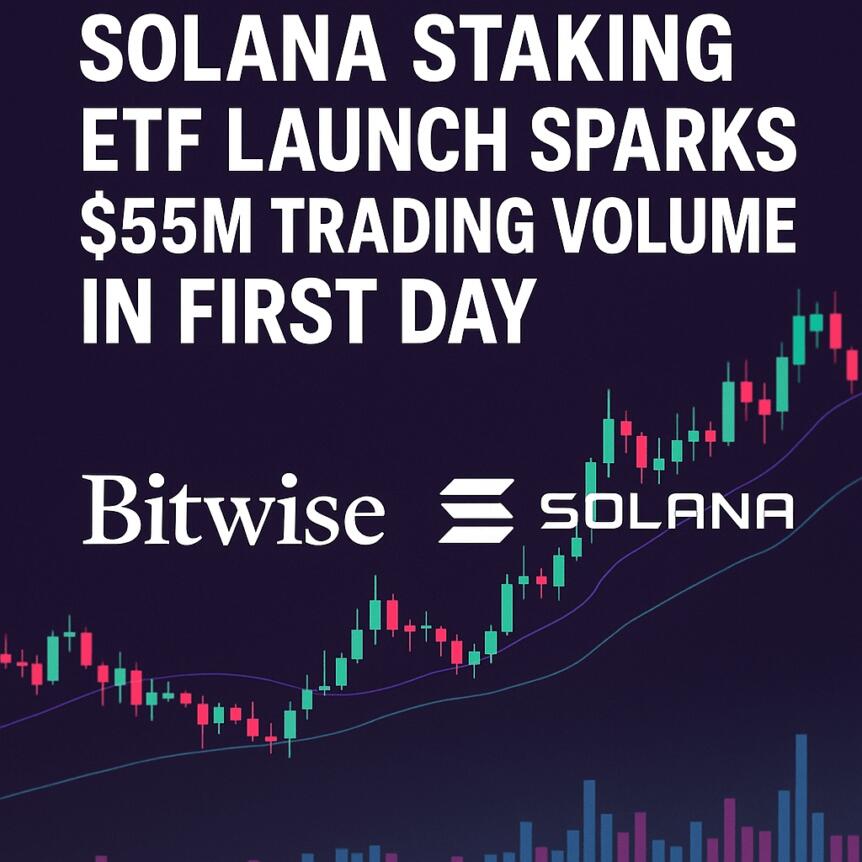Bitwise Solana Staking ETF Launch Sparks $55M Trading Volume in First Day

In a notable development for the crypto industry, asset manager Bitwise’s Solana staking ETF achieved remarkable trading volume on its first day, signaling renewed institutional interest in staking and altcoin investments. Alongside this launch, two other altcoin ETFs from Canary Capital also made their debut, reflecting a growing appetite among investors for diversified exposure to blockchain-based assets amidst evolving crypto market dynamics.
- Bitwise’s Solana ETF (BSOL) topped crypto ETF trading volumes in 2025 with $55.4 million on its launch day.
- The ETF attracted approximately $223 million in assets before trading began, indicating strong institutional confidence in staking cryptocurrencies.
- Other altcoin ETFs from Canary Capital, including HBAR and LTC, saw varied debut volumes, with HBAR matching the analyst’s expectations.
- Despite strong initial trading for BSOL, the ETF’s volume remains significantly lower than Ethereum-focused ETFs, which have seen over $1 billion in daily trading.
- Market interest in crypto ETFs now extends beyond Bitcoin and Ethereum, encompassing riskier assets and innovative mechanisms like staking rewards.
Asset manager Bitwise reported that its newly launched Solana staking ETF, known as BSOL, garnered a trading volume of $55.4 million on its first day, making it the largest among all crypto ETFs launched in 2025. This achievement, highlighted by Bloomberg ETF analyst Eric Balchunas, underscores a rising institutional appetite for blockchain-based financial products, especially those offering staking exposure. Prior to its launch, the ETF attracted roughly $223 million in assets, a clear sign of growing confidence in staking as a viable crypto investment strategy, whereby investors lock up tokens to participate in network validation and earn rewards.
Wall Street’s interest in crypto has expanded beyond traditional market leaders like Bitcoin and Ethereum, with asset managers now launching ETFs tied to riskier cryptocurrencies or featuring mechanisms such as staking. The debut of BSOL exceeded expectations, with trading volume surpassing the pre-launch estimate of $52 million, while other new ETFs like Canary Capital’s HBAR ETF closed at $8 million, matching predictions. However, the Canary Capital Litecoin ETF (LTCC) underperformed, recording just $1 million compared to the estimated $7 million.
 Source: Bitwise
Source: Bitwise
Ether ETFs Dominate Altcoin Fund Debut
While BSOL’s trading volume was substantial for a new altcoin ETF, it remains a fraction of the over $1.08 billion in daily trading volume reported by the nine spot Ether ETFs launched last July — the first wave of altcoin funds introduced in the United States. Notably, most of that volume was driven by inflows into Grayscale’s Ethereum Trust, which alone accounted for $458 million, and BlackRock’s iShares Ethereum Trust ETF, which secured $248.7 million. Bitwise’s spot Ether ETF also contributed $94.3 million in trading activity, significantly outperforming the Solana ETF on its debut.
These trends illustrate that investor focus still heavily relies on Ethereum-related products as the crypto ETF market matures, even as alternative tokens gain some visibility. As the industry continues to evolve, the growing diversification reflects an openness among asset managers and institutional investors to explore riskier crypto assets and innovative staking mechanisms within regulated investment vehicles.
This article was originally published as Bitwise Solana Staking ETF Launch Sparks $55M Trading Volume in First Day on Crypto Breaking News – your trusted source for crypto news, Bitcoin news, and blockchain updates.
You May Also Like

VivoPower To Load Up On XRP At 65% Discount: Here’s How

Shocking Crypto Scam Exposed: Group Referred to Prosecutors Over $4.3M Fraud
